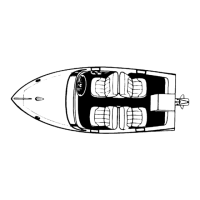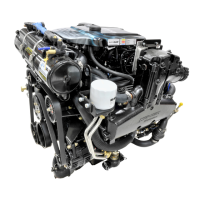VELVET DRIVE V-DRIVE AND WALTER V-DRIVE TRANSMISSIONS - 8B-390-823225--1 1096
Important Information
Shift Control and Cables
!
CAUTION
Shift control and shift cable must position trans-
mission shift lever exactly as stated in this manu-
al, or transmission, as a result of improper shift
lever positioning, will not be covered by Velvet
Drive Warranty.
IMPORTANT: Velvet Drive Warranty is jeopar-
dized if the shift lever poppet ball or spring is
permanently removed, or if shift lever is reposi-
tioned or changed in any manner.
Remote control used must position transmission shift
lever over the letter “F” embossed on transmission
case when remote control is placed in forward gear
position. Transmission failure will occur if transmis-
sion shift lever is positioned over the letter “R” and the
wrong rotation propeller is used to propel boat for-
ward.
Remote control also must provide a total shift cable
travel (at transmission end) of at least 2-3/4 in. (70
mm). This is necessary to position transmission shift
lever fully in the forward and reverse gear positions.
Insufficient shift cable travel will cause transmission
to slip and eventually fail.
Engine
Engine rotation is indicated on engine specifications
and serial number decal on flame arrestor cover. En-
gine rotation is described when observed from the
rear of the engine (transmission end) looking forward
(water pump end).
Installed angle of MIE inboard transmission and
engine should not exceed a maximum of 18° of the
water line.
Transmission
Transmission gear ratio (in forward gear) is marked
on transmission identification plate, which is located
on the port (left) side of transmission. Transmission
output shaft rotation and propeller rotation required
is indicated on a decal on transmission case.
Transmission rotation is described when viewed
from the rear of transmission with transmission in
forward gear selector position.
On MIE engines which are equipped with V-drive
transmissions, transmission output shaft rotation is
the same as engine rotation with transmission in for-
ward gear. Because of reversed engine mounting po-
sition, however, a RH propeller is required, if engine
is LH (CCW) rotation; or a LH rotation propeller is re-
quired, if engine is RH (CW) rotation.
1. DO NOT start or crank engine without fluid in
transmission.
2. Use only recommended fluid in transmission.
3. Except in an emergency, never shift transmission
at engine speeds above 1000 RPM.
4. Free wheeling of one propeller (in a twin engine
boat), at trolling speeds, will not cause damage
to the transmission; however, boat operation
above trolling speed should be avoided. Be sure
proper fluid level exists before free wheeling pro-
peller.
5. DO NOT paint shift lever poppet ball and spring.
An accumulation of paint here will prevent proper
action of the detent.
6. Always replace oil cooler and hoses after a trans-
mission failure or prior to installing a new or re-
built transmission. Metallic particles from a failure
tend to collect in the cooler and hoses and will
gradually flow back into the fluid system and
damage transmission.
7. Always use specified oil cooler, hoses and fit-
tings. Hoses must be at least 13/32 in. (10.5 mm)
I.D. Oil cooler, hoses and fittings must be suffi-
cient size to maintain transmission fluid (in sump)
at 140-190°F (60-88°C).
Propeller
Propeller rotation is described when observed from
the rear of the boat (stern) looking forward (bow end).
The term “left-hand” (LH) refers to rotation in the
counterclockwise (CCW) direction. The term
“right-hand” (RH) refers to rotation in the clockwise
(CW) direction. A LH propeller will move the boat
forward when rotated counterclockwise. A RH pro-
peller will move the boat forward when rotated clock-
wise. Propeller rotation is not necessarily the same
as engine rotation.

